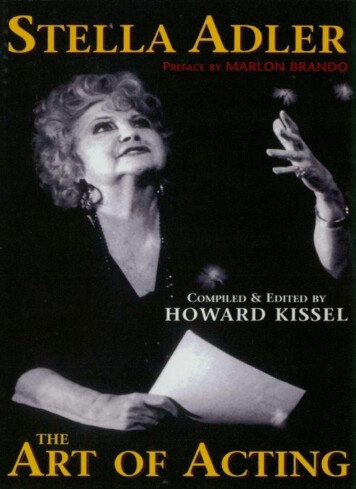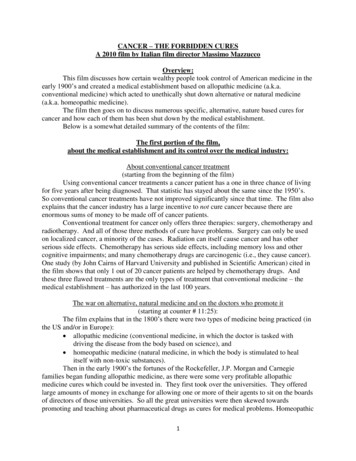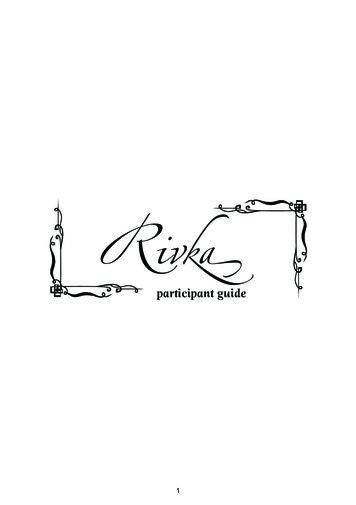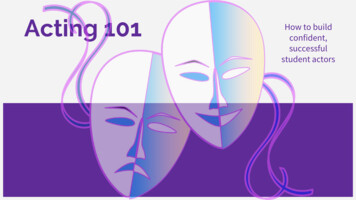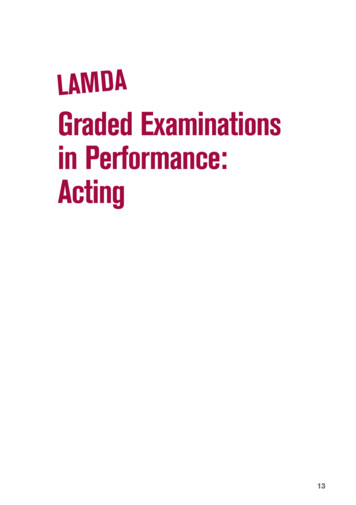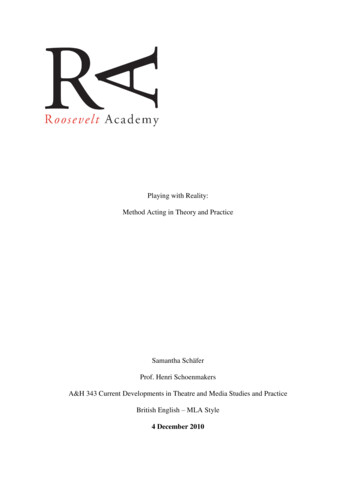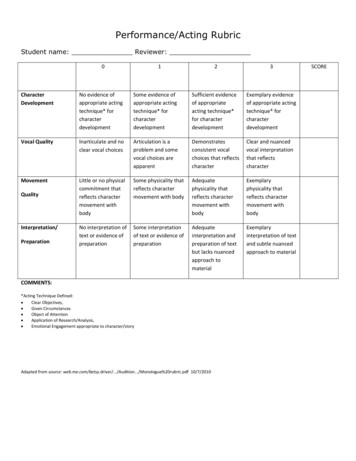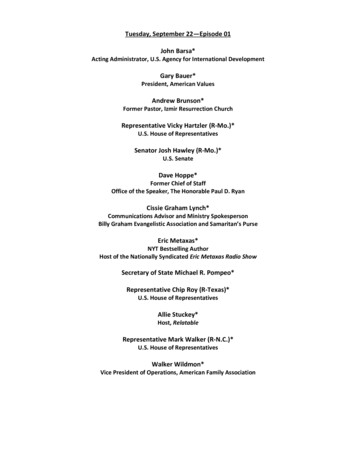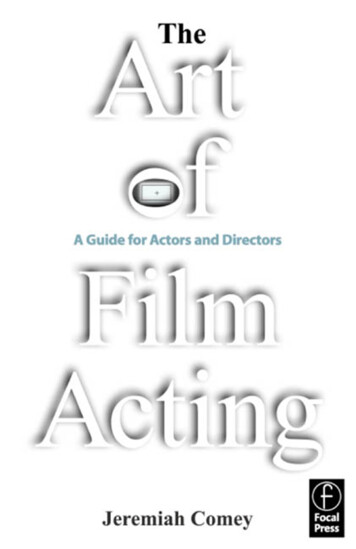
Transcription
The Art of Film Acting
This Page Intentionally Left Blank
The Art of FilmActing: A Guide forActors and DirectorsJeremiah Comey
Focal Press is an imprint of Elsevier Science.Copyright 2002 by Elsevier Science (USA)All rights reserved.No part of this publication may be reproduced, stored in a retrieval system, or transmittedin any form or by any means, electronic, mechanical, photocopying, recording, or otherwise,without the prior written permission of the publisher.Recognizing the importance of preserving what has been written, Elsevier Science prints itsbooks on acid-free paper whenever possible.Library of Congress Cataloging-in-Publication DataComey, Jeremiah.The art of film acting : a guide for actors and directors / Jeremiah Comey.p. cm.Includes bibliographical references and index.ISBN 0-240-80507-0 (pbk. : alk. paper)1. Motion picture acting. I. Title.PN1995.9A26 C65 2002791.43'028--dc212001058628British Library Cataloguing-in-Publication DataA catalogue record for this book is available from the British Library.The publisher offers special discounts on bulk orders of this book.For information, please contact:Manager of Special SalesElsevier Science225 Wildwood AvenueWoburn, MA 01801-2041Tel: 781-904-2500Fax: 781-904-2620For information on all Focal Press publications available, contact our World Wide Web homepage at: www.focalpress.com10 9 8 7 6 5 4 3 2 1Printed in the United States of America
To my wife, Janet, who taught me what love reallymeans, and my daughters, Jessica and Megan, who haveallowed me to experience a second childhood.
This Page Intentionally Left Blank
ContentsPrefacexiAcknowledgments1. The Exercisexiii1Transcript of two actors doing a scene in class. Jeremiahinteracts with them and guides them through the sceneusing the Five Arts 1. Summary 9. Actor Practice 9.2. Stage versus Film Acting10Preparing for a Role 11. The Demands of Performance 12.One Good Performance 13. Projecting 13. Film andTheater Close-Ups 14. Emotions and Feelings 14.Subtext 15. Camera and Proscenium Arch 18.Personality and Character 19. Dialogue 22.Monologues 22. Film Experience versus Stage Experience24. Reacting 25. Summary 26. Actor Practice 27.3. Becoming a Great Actor28The Actor’s Responsibility 28. Casablanca 28. Acting IsBeing and Awareness 29. The Five Arts of Film Acting30. The Power of Relating 36. Acting “On the Nose” 37.Listen to the Other Actor 37. Acting Is a Profession 38.Summary 38. Actor Practice 38.4. Sight Reading42How Sight Reading Works 42. How to Sight Read 43.Importance of Sight Reading 45. Second-Guessing thevii
viiiCONTENTSDirector 45. Multiple Auditions 46. Helpful Hints 46.Summary 46. Actor Practice 47.5. The Art of Concentration48Concentration 48. Internal Rap 48. Interest Is the FocalPoint of Concentration 49. Feedback 50. Emotions 50.Happiness, Sadness, Anger, Fear, Love 52. Differentiatingbetween the Emotions 59. Laughter and Sadness 60.Focused Concentration 63. How to Increase YourConcentration 63. Summary 66. Actor Practice 67.6. The Art of Not Knowing68Everything Happens As If for the First Time 68. BeingIntimate without Taking It Personally 74. Beginner’sMind and Logical Mind 74. After the Scene, Forget It 74.Opinions and Beliefs Will Destroy You 75. Play theCharacter, Not the Stereotype 75. Judgment Is a Trap 78.Leave Your Feelings on the Set 78. Self-Criticism 79.Use Your Beginner’s Mind to Not Know 80. Summary80. Actor Practice 80.7. More on the Art of Not Knowing81The First Time 81. Bad Acting on Film Is the Triumphof Logic 88. Don’t Be Safe 89. The Power of NotKnowing 92. Memorizing and Not Knowing 93.Repeating an Emotional Experience 94. Discover Facts byConcentrating on the Other Actor 94. Judgments RuinYour Acting 97. A Genuine Experience 97. Summary 98.Actor Practice 99.8. Still More on the Art of Not Knowing100The Director’s Ideas 100. Ideas and the Actors 101.The Director’s Vision 101. Good Actors MakeThings Happen 106. Directors Use Blocking to ElicitResponses 110. A Director’s Scene Preparation 111.Importance of the Art of Not Knowing 114.Summary 115. Actor Practice 115.9. The Art of Acceptance117Acceptance 117. Play the Game 120. Trust the RollerCoaster 124. Having Fun 125. Sets and Locations AreReal 128. Summary 128. Actor Practice 129.
Contents10. The Art of Giving and Receivingix131Giving and Receiving 131. Giving, Receiving, andSubtext 137. Accepting Responsibility 138. The RelatingExercise 141. Different Emotional Levels 141. There AreNo Officially Sanctioned Responses 146. Summary 147.Actor Practice 147.11. The Senses148See through Untainted Eyes 148. The Abilities 151. TheMaestro’s Ears 153. The Sense of Touch 158. Touchingto Relax 158. Touching to Stimulate Love 160. Touchingto Provoke Anger 160. Touching to StimulateLaughter 163. Smell and Taste 164. Summary 164.Actor Practice 165.12. Intimacy, Empathy, and Intuition167You Are What You Are: The First Ingredient ofIntimacy 167. Intimacy: The Quality of Good Actors168. Memory and Fear: The Enemies of Intimacy 168.Empathy 171. Intimacy and Empathy 172. Scenes “NotWorthy” of an Actor 174. Physical Actions 176.Intuition: Your Sixth Sense 177. The Creative InnerChild 179. Words That Prevent Good Acting 183. Act,Don’t Think 185. Summary 185. Actor Practice 186.13. The Audition187Getting Ready to Audition 187. Casting for Type.188.Film and Stage Casting 189. Auditioning 190. FilmAudition 191. Acting in Plays 192. Approaches to Acting192. Physical and Emotional Aspects of Characterization195. Imagination 202. Subtext 202. Types of Actors 205.The Message You Send 206. Summary 207. ActorPractice 207.14. More on the Audition209The Casting Director 209. The Job 210. Acting Is aBusiness 210. Why Actors Don’t Get Cast 213. TheDifferences between the Relating Exercise and theAudition 215. The Art of Not Knowing 216. The“Where.” 218. Sides 219. Fear 219. Relaxing 220.Benefit of the Relating Exercise in Audition 220. Skillsfor the Audition 220. Preparation for Audition 225.
xCONTENTSThe Audition 226. Commercial Improvisation 228.Comedic Improvisation 229. Dramatic Improvisation229. Summary 230. Actor Practice 231.15. The Comedy Audition233Comedy and Exposition 233. Characterization 238.Absurd Situations 239. Environment 241. ComedyPatterns 241. Auditioning for Comedy 242. Find theHumor 243. The Elements of Comedy 243. ComicActors 254. Physical Comedy or Farce 255. Punchingand Undercutting 257. Rhythm, Tempo, and Pacing 258.Rehearsal 260. Emotional Ideas 261. Preparing for theComedy Audition 265. In the Audition 265.Summary 266. Actor Practice 267.16. Conclusion268How It Happens 268. Summary 272.Afterword273How to Get in Touch with Jeremiah 275.Bibliography276Videography278Index282
PrefaceFilm acting, like all art, is a form of communication, a relationship with another human being on an emotional level. Vincent van Gogh’s artis an inspiration because he put the most meaningful of ingredients into hispaintings—himself. Just as great artists define themselves by their art, so dobrilliant film actors communicate through their quality, which is personalitycombined with talent.Acting is probably the most competitive business in the world because, forone thing, everyone thinks they can act. If you want to paint, sculpt, or compose music, everyone accepts the necessity for talent and training. No one intheir right mind would think of being a professional concert pianist withouthaving started practice at age four or five. But almost everyone thinks acting iseasy. It is not; but we all can act if we first get out of our own way and forget allthe social and personal inhibitions that have been laid upon us by our parents,our peers, and society. If you want to be a film actor, don’t let anyone discourage you from your dream; but don’t assume that it is quick and easy.Acting is an art, and like the other arts, it demands that you study and master the craft. You also need to be able to expose your true feelings. It is easy tocry when you fight with a lover or watch a tearjerker. But it is another matterto cry in an audition or in a scene. In front of the camera, it can be a nightmarefor an untrained actor simply to be believable and emotionally honest in a sceneas simple as a quiet talk over a cup of coffee. In your everyday life it’s hard toforget your inhibitions and, like a child, be your natural self. To become a goodactor, you have to let the world see your emotions. Sir Laurence Olivier, one ofthe greatest actors, said, “This is not an occupation for adults.”Yet it is possible for a fifty-year-old woman who is inhibited to come intomy class with no previous training and within weeks be giving a good film performance. She will have relapses and will have to keep working hard, butthrough the “Relating Exercise” she is learning how to override her intellectand show her emotions. It’s not easy to take off your emotional clothing andxi
xiiPREFACEshow your real self, but this is what has to happen when you are in a film closeup. Experiences, family, friends, and everyone we have ever met have made apersonal and permanent impact on our inner lives. The performances of greatactors give us insight into these personal relationships and feelings by letting ussee and experience their emotional impact.This book explains how to make the transition to film acting from bothstage acting and everyday life, and how to handle yourself in a professional situation. Reading this book alone will not make you a great actor; but it’s a goodplace to start. Persistent application of its principles can guide you to the confidence and the skill you need to show your talent.When you read this book, take your time. Borrow, rent, or buy all the filmsI use for examples. Study them and the performances I have talked about. Dothe exercises in the book. When you work in other classes or workshops, try theprinciples of the Arts of Concentration, Acceptance, Not Knowing, Giving andReceiving, to help you in the Art of Relating. Relating is your way to attainemotional power. Every time you relate, you release a depth charge thatexplodes and shakes emotions loose from your inhibitions. Then your creativesubconscious—the source of all great art—will force both these and unexpectedemotions to the surface. You will find this process both a revelation and aninspiration, and so will everyone who watches you work.
AcknowledgmentsI am happy to acknowledge help from Howard Gong, who gave meongoing counsel and the will to begin this book and see it through. I owe thanksto Barbara Bowen for allowing me to use her scenes for workshop material; toSamantha Lane, who helped me put my thoughts in order; to Christine Mehnerfor her wide knowledge and support; to my friends and fellow teachers MarkBrandon, Dan Chernau, and Robert Winley, who graciously read the first draftsand helped me find direction; to Allan and Alicia Sirkin and Barbara De Primafor sponsoring my workshop in Miami; to Adam Stoner, who invited me toteach at the New York Film Academy; to Carol Hemingway, Jack Angel,DeeDee Michales, Robert Marcucci, Bob Brisco, and Robert Mckee for theirsupport; to Helene Wong and Vicky Yiannoutsos, who were instrumental inbringing me to New Zealand as a Fulbright grantee to work with writers, directors, and actors.I want to thank the professors and teachers who encouraged me to finishthe book: Joy Rinaldi; Doug McHugh; Dunja Tot; Lynbarbra Mahler; ClayBanks; Nya Daigoa, a gifted artist who designed the cover; and my dear friendPatch MacKenzie, who supported my teaching from the beginning. I am grateful to every student I have had the pleasure to teach, for they have helped melearn.I’ve had the privilege of studying with some remarkable acting teacherswho helped me in my own personal journey—Rudi Solari, Guy Stockwell, StellaAdler, Sherman Marx, Cory Allen, and my first mentor, Charles Conrad, whogenerously started me on my way as a teacher. I especially want to thank WillAdams, a special friend and mentor, for without his expertise and help this bookcould never have been written. But my deepest debt is to Jan, my wife. Her lovehas sustained me throughout.xiii
This Page Intentionally Left Blank
1The ExerciseJack Nicholson, in Five Easy Pieces, single-handedly ushered in a new styleof acting, a brand-new spontaneity that seemed to indicate he was performing without a script.Shirley MacLaineMy aim is to get you to relate to another actor as a real humanbeing—woman to man, boy to girl, mother to daughter, man to man—and notas a person saying words from a script according to some logical idea as to howthey should be said. I’m going to show you how I conduct my film-acting“Relating Exercise” to teach actors how to relate and how to concentrate. Iteach more than the Exercise, but in it you learn the essential skill that sets youon your way to learning all the other skills that are fundamental to your becoming a great actor.Here is a Relating Exercise scene as it was done in my class. A CaliforniaHighway Patrol Officer, Chip, has stopped a beautiful woman, Mary, for speeding and is writing her a ticket. Mary, though a beginning actor, has no troublerelating to Chip. She is open, finds him attractive, and flirts with him. But theactor playing Chip, although he has been on a few auditions, has a problem: he’s“in his head,” which means that he intellectualizes the role and is acting withthe idea that he’s a cop, because the script and his logic have told him he’s acop. So he “acts” how he thinks a cop should act, which, of course, preventshim from relating honestly to Mary. As a result, he is pretty dull and uninteresting. I work with him to get him “out of his head” and to respond to whatMary is doing. When he finally does get out of his head, both he and the scenebecome interesting.The two beginning actors face each other. Earlier, I had asked each to readthe scene once silently, without making any judgments. (As in all scenes in thisbook, the
books on acid-free paper whenever possible. Library of Congress Cataloging-in-Publication Data Comey, Jeremiah. The art of film acting : a guide for actors and directors / Jeremiah Comey. p. cm. Includes bibliographical references and index. ISBN 0-240-80507-0 (pbk. : alk. paper) 1. Motion picture acting. I. Title. PN1995.9A26 C65 2002 791.43'028--dc21 2001058628 British Library Cataloguing-in .File Size: 1MBPage Count: 305
